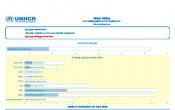Nigeria
Operation: Nigeria
Location
{"longitude":9,"latitude":9,"zoom_level":0}
Latest update of camps and office locations 21 Nov 2016. By clicking on the icons on the map, additional information is displayed.
Key Figures
| 2018 planning figures | |
| 100,000 | refugee returnees will be individually registered |
| 20,000 | IDPs with specific needs will receive material support |
| 7,000 | IDPs will receive cash grants |
| 1,200 | refugee returnees will receive production kits or inputs for agriculture/livestock/fisheries activities |
| 30 | community-based committees/groups have been established and will continue to operate in 2018 on SGBV prevention and response |
| 20 | briefings and meetings with donor countries will be conducted |
| 2016 end-year results | |
| 241,700 | vulnerable people (47,300 households) received core relief items in the six states affected by insurgency and communal violence |
| 143,800 | Nigerian refugee returnees from Niger, Chad and Cameroon were registered |
| 49,100 | individuals received emergency shelter |
| 25,800 | survivors of SGBV were provided with comprehensive specialized services, including psychosocial support to promote their wellbeing |
| 164 | Cameroonian refugees were repatriated, leading to the closure of the rural refugee operation, and 27 individuals were resettled to various countries |
Latest Updates
January - December 2017
People of Concern
| 2016 | 2,911,012 |

[["Refugees",1367],["Asylum-seekers",467],["IDPs",2219272],["Returned IDPs",689906]]
Loading ...
Nigeria
< Back
2016
{"categories":[2013,2014,2015,2016,2017,2018],"budget":[null,null,null,40.906967547,79.76704775,76.299999981],"expenditure":[null,null,null,21.96523424,null,null]}
{"categories":[2013,2014,2015,2016,2017,2018],"p1":[null,null,null,1.82155943,5.83839722,6.104000011],"p2":[null,null,null,null,null,null],"p3":[null,null,null,2.831582997,30.23548234,22.89000044],"p4":[null,null,null,36.25382512,43.69316819,47.30599953]}
{"categories":[2013,2014,2015,2016,2017,2018],"p1":[null,null,null,1.18809322,null,null],"p2":[null,null,null,null,null,null],"p3":[null,null,null,1.5415473,null,null],"p4":[null,null,null,19.23559372,null,null]}
Loading ...
CHOOSE A YEAR
- 2015
- 2016
- 2017
- 2018
Year-end Overview
Plan Overview
Working environment
The ongoing conflict has resulted into a significant humanitarian crisis and forced displacement in North East Nigeria with 6.9 million persons in need of protection services. More than 1.87 million people have been internally displaced, 97 per cent due to the insurgency. The crisis has also had negative consequences on the already fragile political and economic structures of Nigeria.
UNHCR continues with Level 1 registration of returnees from Cameroon, Chad and Niger. The majority of returnees have returned to a situation of internal displacement in North-East Nigeria, and are staying in abandoned public buildings and unorganized IDP settlements close to military camps in liberated areas. Most returnees often end up as IDPs in need of registration services and reintegration assistance, such as shelter, protection-based material assistance and psycho-social support.
Nigeria has a functioning legal and administrative framework for refugee protection. The National Commission for Refugees, Migrants and IDPs (NCFRMI), which is the government agency designated for refugee management, remains UNHCR’s main partner in refugee protection.
UNHCR’s operation in Nigeria is aligned with the Humanitarian Response Plan (HRP), the Regional Refugee Response Plan (RRRP), the UN Development Assistance Framework (UNDAF) and UN Development Action Plan (UNDAP). The Government of Nigeria launched an ambitious recovery programme named the ‘Presidential Committee for the North East Initiative’. UNHCR’s operational plan is informed by the strategy and programmes planned under this initiative.
UNHCR seeks to implement a comprehensive strategy that ensures effective protection and solutions for refugees, asylum-seekers, IDPs and returnees. The strategy is based on the assumption that the situation in North-East Nigeria will improve gradually and that it may take at least two more years before active military operations are finalized and full state authority re-established. UNHCR will implement the protection and solutions strategy in collaboration with various partners, including donors (bilateral and emerging donors, the private sector, and foundations); multilateral organisations including ECOWAS; UN agencies; civil society and international/local non-governmental organizations (NGOs); the media; people of concern including host community representatives.
Key priorities
In 2018, UNHCR will focus on:
- Striving towards implementing the local integration work plan developed in 2016 and sustaining or expanding opportunities for livelihood and self-reliance of refugees;
- Supporting the decision making bodies and agencies through capacity-building to ensure access to asylum in a fair and expeditious manner;
- Issuing biometric national identity and machine readable travel documents to facilitate freedom of movement of refugees;
- Supporting the organized voluntary return in safety and dignity from Cameroon, in light of tripartite agreement already signed;
- Conducting border monitoring, including cross border exchanges. The operationalization of tripartite agreements and protection coordination will remain crucial areas of intervention;
- Promoting sustainable returns and reducing negative coping strategies through promoting and stimulating livelihoods and cash-based interventions;
- For the IDPs, undertaking protection monitoring and analysis, vulnerability screening and response through establishment of protection action groups (PAGs) as well as protection-based material assistance in livelihoods;
- Peacebuilding, access to justice, response to sexual and gender-based violence, psychosocial support and advocacy;
- Conducting capacity-building and awareness on protection related issues; Protection /CCCM Sector Coordination in all 6 North-East States
- Supporting people of concern with the distribution of core relief items and shelter, including through cash-based interventions;
- Advocating for increased engagement with government and other humanitarian actors, and promote strong interactions with development actors to ensure interagency and inter-sectorial complementarity.




